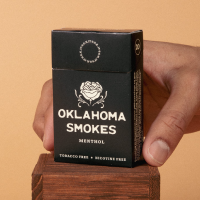Kicking a bad smoking habit can be challenging because you’ll constantly crave just one more puff from your favorite cigarette. It’s why so many people struggle to quit, as those urges to smoke can be strong enough to bring you right back where you started.
Those urges will be at their strongest during the first two weeks after your final puff. While they’ll be hard to manage, no doubt, overcoming tough cravings is entirely possible.
Let’s walk through what you can expect the first couple days after quitting in addition to some great ways that you can lose the lust for tobacco.
Tobacco Timeline: What To Expect
Weaning off the tobacco is one of the few times when quitting is a good thing, and taking this huge step is something to be proud of. Healthy living is within reach, there are just a few hurdles you’re going to have to jump over before you get there.
The withdrawal process is different for everyone, but it’s good to be prepared for the worst so that you aren’t blind sided by the side effects. Your withdrawal symptoms may present yourself like this:
The First Day
Within just the first 4 to 24 hours after your last cigarette, you’ll start experiencing aversive abstinence syndrome. That’s just a fancy medical term for withdrawal.
Some of the earliest symptoms you’ll encounter during this time are physical effects like dizziness or headaches. But when this happens, it’s actually a good thing.
You see, nicotine causes your blood vessels to narrow, which limits the blood flow to your organs and brain. After only a few hours, the nicotine levels in your body drop by half. So these feelings of dizziness are actually a result of your body getting more oxygen.
After the first day, you may also start to feel an increased appetite. This is because nicotine affects the way your brain produces dopamine and serotonin, which are neurotransmitters responsible for letting you know when you’re hungry. People who quit smoking often report having an increased appetite after quitting, so don’t be worried if you feel a bit hungrier than normal.

The First Week
The headaches and dizziness should subside after just the first day or two. You might even start to feel like you’re out of the woods. However, withdrawal symptoms typically peak around the third day.
This is when cravings for another cigarette are going to feel extremely attractive. Nicotine is a highly addictive drug, so you’ll yearn to take just one more puff. However, you have to do everything in your power to resist the urge. Taking one drag will be enough to set you back to the beginning.
During these times, it’s important to remember that cravings usually only last for a few minutes at a time. As long as you can keep yourself distracted during these periods, you’ll be a-okay. We’ll go into specifics a little later on.
The first week is also when you might start experiencing some of the psychological effects associated with withdrawal. Mood changes are very common, and it’s likely that you’ll be irritable and angry at times as your body craves nicotine. Similarly, since the act of smoking is therapeutic for some people, you may start to feel anxious or depressed without it.
Fatigue is also common, as nicotine is a stimulant. Without it, your body may feel like it lacks energy. Oddly enough, it can also make you feel restless at night.
When you have any of these feelings, it’s important to remember that they’re only temporary and they will pass.
The First Month
While some of the symptoms listed above may persist for a few weeks, they’ll gradually subside as time progresses. After the first week, it is likely that you’ll still feel increased appetite, irritability, and fatigue. However, three to four weeks in, you should start to see some of these symptoms disappear.
One symptom that might pop up again after weeks, months, and even years without a cigarette is the urge to smoke another. Addiction and dependence are complex, and it’s going to be challenging to overcome those cravings for the rest of your life.
With that said, you can do it, and we’re here to help. Let’s look at some great ways to overcome even the most inundating nicotine urges.

Ways To Manage Cravings
The most important thing to remember when the inevitable cravings arise is that they are only temporary. In fact, they usually only last for a few minutes at a time. While the first week will be the toughest, these urges may come about sporadically for the rest of your life.
Avoid Triggers
There are certain stimuli that you might associate with smoking a cigarette. Things like going to a bar, drinking a cup of coffee, talking on the phone, or sitting on the back porch might remind you of what it feels like to take a drag.
Especially during the first two weeks, it is important to try to avoid these situations as much as possible because they might persuade you to light up. Now, this isn’t to say you can never go to a bar or drink a cup of coffee ever again. However, you should limit these activities until you’ve been able to break the association with cigarette smoking.
Use Nicotine Replacement Therapy
Quitting cold turkey can be really challenging given all of the withdrawal symptoms that are likely. For many people, it’s helpful to use a Nicotine Replacement Therapy (NRT) that can gradually reduce the amount of nicotine in your system over time.
Popular forms of NRT are things like nicotine patches, gums, or lozenges. These are great, but the only issue is that they don’t quite replace the social and ritualistic aspects that smoking can provide.
This is where CBD smokes can swoop in to save the day. These are tobacco and nicotine-free smokes that provide a satisfying and smooth smoke. They’re designed to feel and look like a normal cigarette, so you won’t have to miss your morning coffee and smoke ritual.
They’re a great way to satisfy your oral fixation while also using an NRT. And our hemp flower smokes right here at Oklahoma Smokes are double lab tested, so you won’t find a harsh chemical, additive, toxin, or pesticide in sight.
Distract Yourself
The best way to overcome a craving is to do anything else to keep yourself distracted. A really great way to do this is by exercising. Not only will this keep your mind focused on something completely different than your urges, but it will also help you stay in good physical shape. It doesn’t need to be anything crazy. Something as simple as a walk around the block can do the trick.
You can also try picking up a new hobby to keep yourself distracted from the often overwhelming withdrawal symptoms. Maybe now’s a good time to try out that new axe-throwing place down the road, or you can teach yourself how to draw or sculpt. Do something that you would have never done if you didn’t decide to stop smoking. It can give you a really great feeling of accomplishment in more ways than one.
The Lowdown
They’re not kidding when they say nicotine is addictive, so the quitting and withdrawal journey is filled with its ups and downs. Physical symptoms like headaches and dizziness might set in within just the first few hours following your final drag, but they usually go away pretty quick.
Symptoms will peak during the first week, probably around day three. Expect mental symptoms like irritability and anxiety, as well as changes in appetite and fatigue. But mostly, be prepared for intense cravings and urges.
After two to four weeks, you’ll likely feel major improvements, but the urge to smoke can persist sporadically for the rest of your life. To combat this, try avoiding situations that remind you of smoking, use a Nicotine Replacement Therapy, consider a CBD smoke, and do anything to keep yourself distracted.
The road to recovery isn’t easy, but it sure is satisfying once you reach the end. Never lose sight of your goals and don’t stop having faith in yourself. You’ve got this.
Sources






